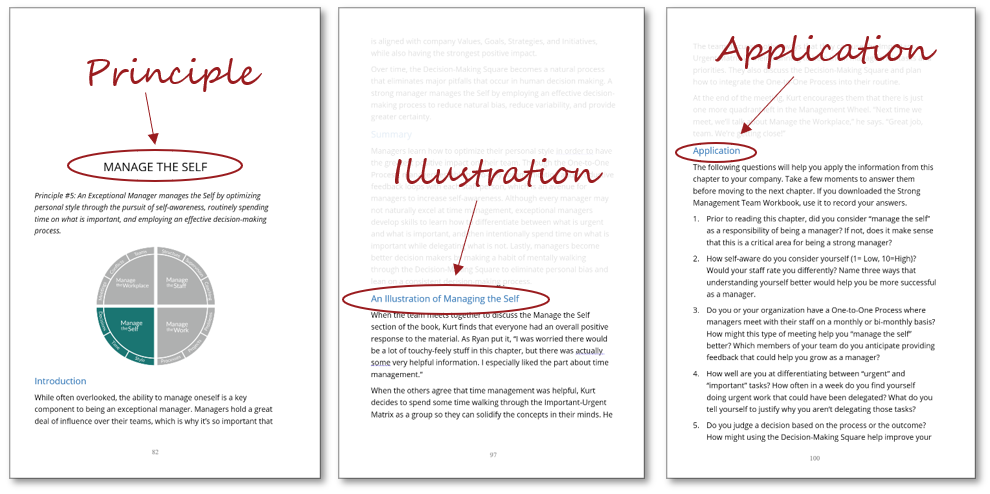The Strong Management Team Guidebook
Managers play a key role in the success of every organization. Despite this fact, few managers are provided with the training and tools they need to be successful. The Strong Management Team book lays out the principles, skills, and tools that managers need—starting with the concept of Ownership Thinking, which empowers managers to start thinking like business owners. When this mindset is applied to the four quadrants of the Management Wheel (Staff, Work, Self, Workplace), managers become the backbone of an exceptional company.
Free Workbook Included!
The Strong Management Team Workbook is a free tool that will help you get the most out of the book. A link to download the workbook can be found in multiple places throughout the book. The workbook includes space to take notes as well as room to record your responses to the application questions found at the end of each chapter.
Take a Look Inside
Each chapter addresses a topic related to a Strong Management Team. The chapter begins with an explanation of the principle that is involved and follows with examples of what it looks like when the principle is applied to a business. At the end of each chapter there is an application section with questions that will help you apply the principle to your business.
“One more great resource from The ReWild Group to support small/medium size businesses that don’t have big business budgets but need the same business acumen infused into their company.”
An Overview of the Strong Management Team Guidebook
A Strong Management Team is the backbone of an exceptional business. Owners and CEOs who can confidently delegate work to well-trained managers are able to spend more time working on the business—developing strategies and setting a clear vision for the team. This book is packed with powerful tools to help managers understand their role and how to excel in the four key areas of management: self, staff, work, and workplace. Each chapter explores one of the principles in-depth and then illustrates how it looks when applied to Lakeview Home Care, a fictional company. Below is an overview of the major concepts that inform Strong Management Team. For more details, including illustrative examples, get a copy of the book.
Strong Management Team Principles
Managers drive productivity, engagement, and retention in organizations, making them a critical factor in the organization's success. Strong managers share the following three characteristics: 1) they understand the scope of their responsibilities as managers; 2) they possess the necessary management skills; and 3) they exhibit ownership thinking.
The Management Wheel organizes the four areas a manager must successfully manage: themselves, the staff, the work, and the workplace. Managers likely have areas of strength and weakness amongst these areas, but the goal is to develop a management team that can effectively and consistently manage each one.
Our research shows that there is an optimal number of managers and leaders depending on a company’s Stage of Growth. Based on the number of employees, the Stages of Growth show us that organizations move from being owner-centric to enterprise-centric in Stage 3, when there are 20-34 employees. It’s critical for CEOs to develop managers at this point who can begin to take responsibility over areas of the business. Otherwise, as more people join the company, the CEO is stretched too thin, making further growth unsustainable.
Ownership Thinking
A business owner is concerned about things like profit, cash flow, competition, employees, and cost control (among others). While employees are typically concerned about things like salary, benefits, job security, and immediate tasks, the business will function at a higher level when employees begin to think more like business owners. We call this mindset Ownership Thinking. It’s not bad for employees to think about their own needs, but with Ownership Thinking they consider the needs of the business as well.
Ownership Thinking begins with the leadership and management team. The more the leadership and management teams think like an owner, the stronger the company will become. As managers grow in their understanding of the company and of business in general, they can be more effective, generate more value for the company, and position themselves to gain more responsibility.
The Thinking-Doing Sequence is a visual tool that directs a leader’s attention to the four main areas of activity: Critical Thinking, Focusing, Planning, and Doing. While Planning and Doing come naturally to most business owners, the first two steps in the sequence are easier to ignore. Without enough energy spent on Critical Thinking and Focusing, the company can easily get off-course or not recognize changes occurring in the marketplace.
While leaders should spend time in all four steps of the sequence, it is generally true that the higher the role in the organization and the larger the business, the more time one should spend on the first two steps (Critical Thinking and Focusing) rather than the last two (Planning and Doing).
Manage the Staff
The Manage the Staff quadrant of the Management Wheel covers the principles that should inform and drive the actions of strong managers as they relate to their direct reports. Beginning with the basic structure of how positions are organized, managers understand the principles of governance and how to create Functional Org Charts and Position Role Sheets that give staff clarity about their roles and responsibilities. They know what it takes to create a climate in which everyone is clear about expectations, receives the support needed to accomplish well-defined goals, and where appropriate rewards are given when expectations are met. Lastly, managers are attuned to opportunities for coaching and development of their staff; they look for ways to bring out the highest and best in their team.
Manage the Work
The Manage the Work quadrant of the Management Wheel covers the principles that should inform and drive the actions of strong managers as they relate to this body of work they’ve been assigned—their team’s specialization. As effective problem solvers, managers must learn how to remove obstacles that prevent the work from being accomplished. They understand the dynamics of project management and how to manage the scope, resources, and timeline of projects that achieve improvements in the organization. They also understand and appreciate good processes, and fully utilize them to achieve greater quality and consistency in the work that is produced.
Manage the Self
The Manage the Self quadrant of the Management Wheel covers the principles that should inform and drive the actions of strong managers as they seek to be self-aware and bring their highest and best to their jobs. While everyone has natural strengths and weaknesses, exceptional managers seek to improve their self-awareness so they can build on strengths and improve their weaknesses. They engage with their team in productive dialogue and feedback through the One-to-One Process; they hone their time management skills; and they learn techniques to become sound decision-makers.
Manage the Workplace
The Manage the Workplace quadrant of the Management Wheel covers the principles that should inform and drive the actions of strong managers as they relate to the workplace. This begins with creating structure around meetings, so these important gatherings are productive and effective. Managers must excel at conflict management, setting a standard for the team that says conflict is unavoidable and can be beneficial to the workplace when handled correctly. Managers also need to understand the dynamics of teams and the phases of development as they form, encounter problems, establish good patterns, and achieve results. By leading teams through these different phases, managers reduce conflict and help create a workplace in which people are glad to be a part.
Get the Strong Management Team Guidebook today!
Explore the entire Elements Book Series!
Organizational Structure is just one book in our series called Organizational ReWilding: 11 Elements of an Exceptional Business. Each book addresses a fundamental element of what comprises a great company.
The books are divided into four categories: Leadership, Infrastructure, Strategy, and Culture. Each one follows the same format as Organizational Structure, with chapters structured to explain a principle, illustrate what it looks like in practice using a fictional company, and closing with application questions designed to help you apply the principle to your own business. Click below to learn more.






